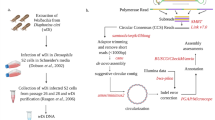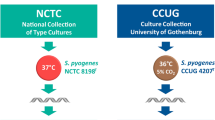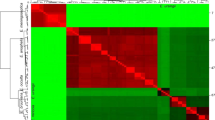Abstract
Neochlamydia strain S13 is an amoebal symbiont of an Acanthamoeba sp. The symbiont confers resistance to Legionella pneumophila on its host; however, the molecular mechanism underlying this resistance is not completely understood. Genome analyses have been crucial for understanding the complicated host–symbiont relationship but segregating the host’s genome DNA from the symbiont’s DNA is often challenging. In this study, we successfully identified a bimodal genomic structure in Neochlamydia strain S13 using PacBio RS II supported by ultra-long reads derived from MinION. One mode consisted of circular sequences of 2,586,667 and 231,307 bp; the other was an integrated sequence of the two via long homologous regions. They encoded 2175 protein-coding regions, some of which were implied to be acquired via horizontal gene transfer. They were specifically conserved in the genus Neochlamydia and formed a cluster in the genome, presumably by multiplication through genome replication. Moreover, it was notable that the sequenced DNA was obtained without segregating the symbiont DNA from the host. This is an easy and versatile technique that facilitates the characterization of diverse hosts and symbionts in nature.
This is a preview of subscription content, access via your institution
Access options
Subscribe to this journal
Receive 12 print issues and online access
$259.00 per year
only $21.58 per issue
Buy this article
- Purchase on Springer Link
- Instant access to full article PDF
Prices may be subject to local taxes which are calculated during checkout





Similar content being viewed by others
References
Matsuo J, Kawaguchi K, Nakamura S, Hayashi Y, Yoshida M, Takahashi K, et al. Survival and transfer ability of phylogenetically diverse bacterial endosymbionts in environmental Acanthamoeba isolates. Env Microbiol Rep. 2010;2:524–33. http://www.ncbi.nlm.nih.gov/pubmed/23766223.
Ishida K, Sekizuka T, Hayashida K, Matsuo J, Takeuchi F, Kuroda M, et al. Amoebal endosymbiont Neochlamydia genome sequence illuminates the bacterial role in the defense of the host amoebae against Legionella pneumophila. PLoS ONE. 2014;9:1–9.
Okude M, Matsuo J, Nakamura S, Kawaguchi K, Hayashi Y, Sakai H, et al. Environmental chlamydiae alter the growth speed and motility of host acanthamoebae. Microbes Environ. 2012;27:423–9. http://www.ncbi.nlm.nih.gov/pubmed/23100025.
Buultjens AH, Lam MMC, Ballard S, Monk IR, Mahony AA, Grabsch EA, et al. Evolutionary origins of the emergent ST796 clone of vancomycin resistant Enterococcus faecium. 2017;5:e2916.
Simões PM, Lemriss H, Dumont Y, Lemriss S, Rasigade J-P, Assant-Trouillet S, et al. Single-molecule sequencing (PacBio) of the staphylococcus capitis NRCS-A clone reveals the basis of multidrug resistance and adaptation to the neonatal intensive care unit environment. Front Microbiol. 2016;7:1–11. https://doi.org/10.3389/fmicb.2016.01991/full.
Wei Y, Cao J, Fang J, Kato C, Cui W. First complete genome sequence of marinilactibacilluspiezotolerans strain 15R, a marine lactobacillus isolated from coal-bearing sediment 2.0 kilometers below the seafloor, determined by pacbio single-molecule real-time technology. Genome Announc. 2017;5:e01625–16. https://doi.org/10.1128/genomeA.01625-16.
Chain PSG, Grafham DV, Fulton RS, Fitzgerald MG, Hostetler J, Muzny D, et al. Genomics. Genome project standards in a new era of sequencing. Science. 2009;326:236–7. https://doi.org/10.1126/science.1180614.
Stephens ZD, Lee SY, Faghri F, Campbell RH, Zhai C, Efron MJ, et al. Big data: astronomical or genomical? PLoS Biol. 2015;13:e1002195 http://www.ncbi.nlm.nih.gov/pubmed/26151137.
Khan NA. Acanthamoeba: biology and increasing importance in human health. FEMS Microbiol Rev. 2006;30:564–95.
Chin C-S, Alexander DH, Marks P, Klammer AA, Drake J, Heiner C, et al. Nonhybrid, finished microbial genome assemblies from long-read SMRT sequencing data. Nat Methods. 2013;10:563–9. https://doi.org/10.1038/nmeth.2474.
Langmead B, Salzberg SL. Fast gapped-read alignment with Bowtie 2. Nat Methods. 2012;9:357–9. http://www.ncbi.nlm.nih.gov/pubmed/22388286.
Walker BJ, Abeel T, Shea T, Priest M, Abouelliel A, Sakthikumar S, et al. Pilon: an integrated tool for comprehensive microbial variant detection and genome assembly improvement. PLoS ONE. 2014;9:e112963 http://www.ncbi.nlm.nih.gov/pubmed/25409509.
Noe L, Kucherov G. YASS: enhancing the sensitivity of DNA similarity search. Nucleic Acids Res. 2005;33(Web Server issue):W540–3. http://www.ncbi.nlm.nih.gov/pubmed/15980530.
Darling AC, Mau B, Blattner FR, Perna NT. Mauve: multiple alignment of conserved genomic sequence with rearrangements. Genome Res. 2004;14:1394–403. http://www.ncbi.nlm.nih.gov/pubmed/15231754.
Parks DH, Imelfort M, Skennerton CT, Hugenholtz P, Tyson GW. CheckM: assessing the quality of microbial genomes recovered from isolates, single cells, and metagenomes. Genome Res. 2015;25:1043–55. http://www.pubmedcentral.nih.gov/articlerender.fcgi?artid=4484387&tool=pmcentrez&rendertype=abstract.
Cardozo T, Pagano M. The SCF ubiquitin ligase: insights into a molecular machine. Nat Rev Mol Cell Biol. 2004;5:739–51. http://www.ncbi.nlm.nih.gov/pubmed/15340381.
Kipreos ET, Gohel SP, Hedgecock EM The C. elegansF-box/WD-repeat protein LIN-23 functions to limit cell division during development. Development. 2000;127:5071–82.
Kobe B, Kajava AV. The leucine-rich repeat as a protein recognition motif. Curr Opin Struct Biol. 2001;11:725–32.
Smith TF, Gaitatzes C, Saxena K, Neer EJ. The WD repeat: a common architecture for diverse functions. Trends Biochem Sci. 1999;24:181–5.
Ashida H, Kim M, Sasakawa C. Exploitation of the host ubiquitin system by human bacterial pathogens. Nat Rev Microbiol. 2014;12:399–413. http://www.ncbi.nlm.nih.gov/pubmed/24801936.
Choy A, Dancourt J, Mugo B, O’Connor TJ, Isberg RR, Melia TJ, et al. The Legionella effector RavZ inhibits host autophagy through irreversible Atg8 deconjugation. Science. 2012;338:1072–6. https://doi.org/10.1126/science.1227026.
Kubori T, Hyakutake A, Nagai H. Legionella translocates an E3 ubiquitin ligase that has multiple U-boxes with distinct functions. Mol Microbiol. 2008;67:1307–19.
Kubori T, Shinzawa N, Kanuka H, Nagai H. Legionella metaeffector exploits host proteasome to temporally regulate cognate effector. PLoS Pathog. 2010;6:1–8.
Price CTD, Al-Quadan T, Santic M, Rosenshine I, Abu Kwaik Y. Host proteasomal degradation generates amino acids essential for intracellular bacterial growth. Science. 2011;334:1553 LP–1557. http://science.sciencemag.org/content/334/6062/1553.abstract.
Zhao L. Genomics: the tale of our other genome. Nature. 2010;465:879–80. http://www.ncbi.nlm.nih.gov/pubmed/20559375.
López C, Saravia C, Gomez A, Hoebeke J, Patarroyo MA. Mechanisms of genetically-based resistance to malaria. Gene. 2010;467:1–12. https://doi.org/10.1016/j.gene.2010.07.008.
Goodrich JK, Waters JL, Poole AC, Sutter JL, Koren O, Blekhman R, et al. Human genetics shape the gut microbiome. Cell. 2014;159:789–99. https://doi.org/10.1016/j.cell.2014.09.053.
Jeyakumar T, Beauchemin N, Gros P. Impact of the microbiome on the human genome. Trends Parasitol. 2019;1–13. https://doi.org/10.1016/j.pt.2019.07.015.
Acknowledgements
We thank Aiko Ohnuma and Naoko Kawai for conducting sequencing. This study was supported by grants-in-aid for Japan Society for the Promotion Science (JSPS) KAKENHI, grant numbers 16K15270, 26670206, 24659194, and 24117501 “Innovation Areas (Matryoshka-type evolution).”
Author information
Authors and Affiliations
Corresponding author
Ethics declarations
Conflict of interest
The authors declare that they have no conflict of interest.
Additional information
Publisher’s note Springer Nature remains neutral with regard to jurisdictional claims in published maps and institutional affiliations.
Supplementary information
Rights and permissions
About this article
Cite this article
Yamagishi, J., Hayashida, K., Matsuo, J. et al. Complete genome and bimodal genomic structure of the amoebal symbiont Neochlamydia strain S13 revealed by ultra-long reads obtained from MinION. J Hum Genet 65, 41–48 (2020). https://doi.org/10.1038/s10038-019-0684-3
Received:
Revised:
Accepted:
Published:
Issue Date:
DOI: https://doi.org/10.1038/s10038-019-0684-3



